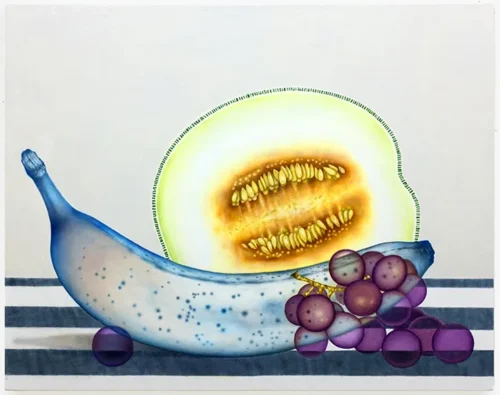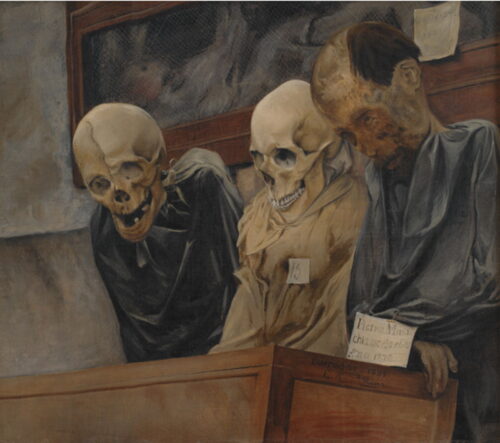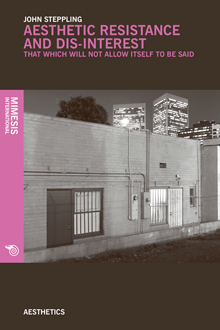
Domenico Peterlini (Dante, 1860)
“Even the sympathetic curiosity of the wisest discerner of men does not suffice to divine how this or that woman gets along with the solution of this enigma and the enigma of this solution; what dreadful, far-reaching suspicions must awaken thereby in the poor unhinged soul; and forsooth, how the ultimate philosophy and scepticism of the woman casts anchor at this point! Afterwards the same profound silence as before: and often even a silence to herself, a shutting of her eyes to herself. Young wives on that account make great efforts to appear superficial and thoughtless; the most ingenious of them simulate a kind of impudence. Wives easily feel their husbands as a question-mark to their honour, and their children as an apology or atonement, they require children, and wish for them in quite another spirit than a husband wishes for them. – In short, one cannot be gentle enough towards women!”
Friedrich Nietzsche (Gay Science, Aphorism #71 On Female Chastity)
“The mindless tasks imposed by authoritarian culture on the subject classes can be performed only at the cost of permanent regression.”
Theodor Adorno (Minima Moralia)
“Just as man-by nature-desires what is able to sustain and revive the lust of hfe. so does he who is to live for the eternal need constantly a dose of pessimism, so that he should not dote upon this wretched world, but rather learn loathing and weariness of and disgust at its foolishness and lies. “
Søren Kierkegaard (Attack on Christendom)
“At the heart of internet culture is a force that wants to know everything about you. We think of privacy as a human right, but we live in a Facebook age, when all that matters is publicity. . . . Privacy has meaning only for an individual. And we are no longer individuals. We believe in ourselves, but our selves are no longer our selves. We are not the same people who we once were.”
Richard Thieme (conversation at Hacker Convention DEF-CON25, 2021)
I have been writing recently about the pathologies fostered by advanced Capitalism. A variety of psychopath actually does well in this system, as do pathological narcissists. And I was reading yet more statistics about the dramatic drop in birth rates globally. The fertility rate has halved since mid 20th century. Most countries will have lost forty to fifty percent of their population over the next forty years. Japan has been seeing dramatic drops in births over the last decade. Italy as well, and Singapore and South Korea. There are dozens of countries in South America, and Europe with below replacement level birth rates. It is very difficult to make general statements about the reasons for this. In many countries (like Italy) its not lack of desire for having children, its almost purely economic. In others it is a generalized fear (climate, wars, enviromental destruction, bad food, etc), and then there is a growing percentage of the global population that just don’t want to be parents. But why?
And I have been thinking a lot about the nature of parenthood, and of the contours of contemporary relationships. By which I mean primarily romantic relationships. And this touches on the nature of desire, and relates to both, or really the last three posts I’ve written here. And at this point I feel like touching on Wilhelm Reich again, on the compulsive moral constraints that remain in place, in the West anyway. But such matters are prone to being reductive and over simplistic. And it is also dangerous to give too much importance to anecdotal experience. It is, of course, impossible not too, but caution needs to be exercised.

Justin Duffus
Countries, for the record, below replacement rate include the U.S., Thailand, Germany, India, Italy, Hungary, the U.K., Brazil and Sweden. I believe Norway is right on the edge. Mexico is right at the edge, as is Morocco. But in Europe and North America, the numbers have fallen decisively. In every country I could find, men wanted children more than women. With the sole fascinating exceptions of Germany and the U.S.
Men in the first world seem not to want children. Not nearly at the level of Africa and Asia. Fertility issues in the U.S. were the highest in the world. Globally, half of all pregnancies are unintended. Ok, well, you can look up the details of all this, but the more interesting aspect is how desire has changed, and how ideas of romance and marriage have changed.
“From the nineteenth century until the late twentieth century, pregnancy was considered a medical condition and/or something to hide from public view. In recent years, women’s pregnant bodies have been displayed in ways that could not have been imagined just a few decades ago. A wave of recent Hollywood films have pregnancy as a main theme, showing bare pregnant bellies, water breaking, and vaginal birth and discussing the experience of pregnancy as never before in popular film.”
Kelly Oliver (Knock Me Up, Knock Me Down,Images of Pregnancy in Hollywood Film and Popular Culture)
This seems counter intuitive to a degree. But like the idea, the symbolic idea of the Father changed, so the symbolic family still seems to occupy the cultural landscape, though in modified ways.
“…the pregnant body may be a screen for our fantasies and fears about ourselves as people and as a people.”
Kelly Oliver (Ibid)
Oliver notes that in Hollywood films of the 40s and 50s pregnant women were never seen, the story went from romance to marriage to instant family. Of course a good part of this was the Hayes Production Code that prohibited the showing of childbirth and advanced states of pregnancy. In the 60s and 70s, technology helped change perception. Ultrasound and DNA testing, and given the space race the idea of alien impregnation was a relatively common theme. The first sperm bank opened in 1972.

Philipp Lohofener, photography.
“This image of fetus as space hero came to life on the big screen in Stanley Kubrick’s 1968 masterpiece 2001: A Space Odyssey. The film ends with a fetus floating into space, completely unmoored from the seemingly obsolete maternal body. Kubrick’s film engages issues of evolution, progress, and human development; more specifically, it juxtaposes the human to apes, machines, and possible alien intelligence. It is noteworthy that other films from this period display similar anxieties about the human and humanity in relation to gestation and birth. Released the same year, Roman Polanski’s Rosemary’s Baby turns pregnancy into a nightmarish pact withthe devil to gestate his spawn.”
Kelly Oliver (Ibid)
In the 70s and 80s the feminist writing on this topic (Kristeva, Irigary, Marion Young) was analysing what was seen as a new subjectivity of motherhood.
“New reproductive technologies exploded onto the market in the 1980s and 1990s. In 1978 the first “test- tube baby” was born. In 1981 the first baby was born as a result of in vitro fertilization (IVF). “Baby M” was born in 1986, and surrogacy started making headlines. In 1997 Dolly the sheep was cloned, and that same year the oldest known pregnant woman gave birth at age sixty- three. In 1998 sperm banks were taking in $164 billion a year, and fertility clinics were growing industries.”
Kelly Oliver (Ibid)
See Schwarzenegger’s film Junior(1992) and Look Who’s Talking (1989) as interesting side bar examples of societal shifts.
Demi Moore was photographed for the cover of Vanity Fair in 1991, naked and pregnant.

Jason Mitcham
“At the same time, however, the skin-tight reflective surfaces make her pregnant belly appear as yet another celebrity accessory to be glamorized and objectified. It is as if Demi Moore is wearing her pregnant body as the latest fashion. This sentiment is all the more poignant insofar as Moore appears on another Vanity Fair cover a year later, with her thin postpartum body covered in body paint that looks like she is wearing a man’s suit. In this later photo, in a strange sense echoing the first, she is literally wearing her skin.”
Kelly Oliver (Ibid)
In the early 2000s, Hollywood turned out a dozen (or more) romantic comedies about pregnancy. But this was a bourgeois projection, in a sense. Marketing had taken over the filmic unconscious and now ‘having a baby’ was framed in fantasy contexts and a decade into the 2000s the term ‘biological clock’ had entered the popular lexicon. Woman and couples were waiting longer to have children. This again, however, was the affluent white world of Hollywood. More and more adults were childless but Hollywood did not see that as a useful theme.
Ok, the point is that Hollywood often serves as a barometer of cultural opinion. And running through all of this, from the 40s to the current moment, ambivalence is foregrounded. Among the countless studies and surveys on childlessness a theme keeps cropping up and that is that being without children (nulliparous) is no indicator for success or happiness. Much like pathological narcissists and psychopaths. Childfree, another term often used, seems to suit advanced capitalism, especially if you are a woman. I am not suggesting the choice to not have children equates with sociopathy but I do think, anecdotally speaking, that the adults I know who have no kids often display other personality and character problems. This is more true, perhaps surprisingly, for men than women. I think for men in western capitalist society the idea of not being a father by age forty five feels like a masculinity deficit. I do not think woman at that age, who have chosen to be nulliparous, in my experience anyway, have quite the same degree of psychological issues. But what does one mean by ‘problem’. Raising children can, for sure, interfere with career. It is a massive commitment of time and energy. It is exhausting. And the economic pressures multiply those commitments tenfold. But I do think there is an ambivalent quality in the child-less adult.
“…politicians have been harping on family values and the need to honour the family as the cure all for social ills, now seen as evidence of moral decay caused by the fall of that short-lived nuclear family. Recent celebrations of paternal responsibility and authority continue to make headlines with the Million Man March in October 1995 and the Stand in the Gap Promise Keepers revival in October 1997.”
Kelly Oliver (Subjectivity without subjects : from abject fathers to desiring mothers)
The problem with these revivals of paternal authority is that (and this includes Oliver’s analysis) the Oedipal narrative is ignored. And that continues to be a critical aspect of today’s ‘Father’, capital F, and the material erosion of psychological health.

Amanda Baldwin
“Development of the feminine type is an entirely different story. A different course is followed in the type of female most frequently met with, which is probably the purest and truest one. With the onset of puberty the maturing of the female sexual organs … seems to bring about an intensification of the original narcissism, and this is unfavourable to the development of a true object-choice with its accompanying sexual overvaluation. Women, especially if they grow up with good looks, develop a certain self-contentment [eit!e Selbstgeniigsamkeit] which compensates them for the social restrictions that are imposed upon them in their choice ofobject. Strictly speaking, it is only themselves that such women love with an intensity comparable to that of the man’s love for them. Nor does their need lie in the direction of loving, but of being loved, and the man who fulfills this condition is the one who finds favour with them. The importance of this type of woman for the erotic life of mankind is to be rated very high.”
Sigmund Freud (On Narcissism)
Narcissists are found to be very attractive, especially (though I am not sure) female narcissists, to certain men (per Kofman) who have rejected their own narcissism, and are in search for a validation of themselves. This is not totally unlike the Trophy Wife phenomenon. It is the organic version of this syndrome. And such narcissism, is per Kofman again, why children are often so charming — their narcissism and their guileless self contentment. Cats have this quality. And it is the opposite of ‘needy’, which in both genders is so unappealing. In late stage capitalism, coinciding with second wave feminism, the young women of the U.S. (in particular) are stunningly frozen, psychologically. This does not mean erotically frigid at all, this is a kind of psychological/cognitive paralysis that comes with their advanced narcissistic character armouring. My impression of American women is that of being highly defended. The shiny reflective surface that Oliver notes describing Demi Moore, has infiltrated all of the culture. The high gloss finish. The scratch-proof high shine polish for your expensive car. It is also the best look for screen reproduction. In that sense, everyone takes on qualities of the porn actor.
“What makes woman enigmatic here is no longer some “inborn deficiency,” some sort of lack, but on the contrary her narcissistic self-sufficiency and her indifference; it is no longer the woman who envies man his penis, it is he who envies her for her unassailable libidinal position, whereas he himself–one may wonder why-has been impoverished, has been emptied of this original narcissism in favor of the love object.”
Sarah Kofman (Enigma of Woman)
Kofman’s observations above are very insightful. Penis envy has become male envy of the unassailable. The ‘shiksa’ goddess, the Princess, only now its an Only Fans princess. Men, especially after the age of thirty or thirty five, want submission. More than anything, they want the woman to yield. And this is partly the results of post third wave feminism, but also the age of marketing. Self branding means you can demand a price your agent (who is imaginary) will quote. Men don’t perform in the bedroom, or not at first anyway, they perform economically.
“…what is attractive in woman is that she has managed to preserve what man has lost, that original narcissism for which he is eternally nostalgic.”
Sarah Kofman (Ibid)

Adama Kouyate, photography (Mali, 1967)
Criminals are attractive in the same self contained manner. But this inches into sacrifice. Bullfighters, matadors, are both feminine and masculine. That is their appeal, they need neither. But it is also their proximity to death (sacrifice). Boxers have no shortage of women. Even the ugliest. I’ve seen that. First hand. And criminals –and this is something great writers have understood for centuries, really. Cowardice is the single most unattractive quality in the world. It is not risk taking (though risk averse is a turn off, too), because there are a lot of unappealing risk takers. It is the not caring about the risk. Or, knowing, but not caring. And here we arrive at sacrifice again. It is the quality of contempt, too. Contempt for bourgeois norms. Girls like bad boys. But why?
And here, a post that began with pregnancy has arrived at death. And death is accompanied by art.
“Risk management is a familiar idea in our current world, where talking infants on E*TRADE commercials propagate the imperative to invest. In a climate of economic uncertainty, everyone must protect his or her investments. The financial connotation of risk as something negative, quantifiable, and subject to limitation appears inverted in Adorno’s aesthetic theory: for him, risk is advantageous and qualitatively essential to artworks. New artworks that resist commodification pose a danger to corporate-minded and art-minded people alike.”
Terrence Renaud (Risk, Miscarriage, and Exile: The Critical Hazards of Adorno’s Aesthetic Theory)
Artists are attractive, too. Now a moment’s digression. In the movie Dr. Zhivago, when I saw it as a kid, I was, of course, in love with Julie Christie (Im still in love with Julie Christie) but I was indifferent to Omar Shariff. I liked that he was Arab. But I was very struck by the communist, Tom Courtney. We, the audience were not meant to love Courtney, but such is the stupidity of Hollywood. Because Courtney was the sexy character in that film and it was, again, sacrifice and the unassailable. And self sacrifice. End pseudo-digression. Artists who do not risk (like 99.9% of American theatre artists for example) are not artists. Adorno again makes use of metaphors from female reproduction. Still births, after birth, etc.

Ans Markus (1982)
“This “appearance of an other” alludes to the uncanny feeling of birthing a child—a being both familiar and foreign. While the proper German adjective for pregnant in the maternal sense is schwanger, not prägnant, the Latin roots of the latter clearly imply maternity. Artworks carry within themselves the “other”: “Art possesses its other immanently because, like the subject, immanence is socially mediated in itself. It must make its latent social content eloquent: It must go within in order to go beyond itself”. If this Other is art’s fait social, then a successful artwork “gives birth” to its social truth content. For a critic like Adorno, social truth translates into historical suffering. There can be no happy art.”
Terrence Renaud (Ibid)
I am trying to sort of lay the groundwork for understanding the implications of a decisive fall in birth rates around the world. For philosophically the idea of paternity and maternity are hugely significant. And one realizes, or starts to realize, that so much of identity politics is just pure distraction. Few people seem interested in discussing this falling birthrate. And yet, it is essential to understanding our sense of who we are.
I think another problem worth mentioning is the state of Academia. The financial aims of big Universities means graduate students will do whatever work and research they deem to be economically suited to future employment. Period. The humanities don’t fit into future job searches, and certainly philosophy doesn’t. The classics don’t. If you sign on to Academia you have signed a pact. You will not (unless you are one of those attractive criminal high risk types and in that case you won’t last long within the institutions of higher learning) be able to develop as a human being. Or it will be very hard. And this segues into the topic of career.

Tom Courtney (Dr Zhivago, dr. David Lean, 1965)
But as Adorno noted (and this runs throughout his work) domination is sacrifice.
“Domination inevitably implies sacrifice: ‘the ego owes its existence to the sacrifice of the present moment to the future. Abstraction, the modus operandi of scientific control, is nothing other than the sacrifice of the particular to the universal. “
Robert Hullot-Kentor (Introduction to Adorno’s Kierkegaard: Construction of an Aesthetic)
Planned communities were sold as a vision of the ‘future’. Progress. It was Disney’s Tomorrowland. It was also the same dream the Nazis had.
“Adorno’s aim an tracing out this dialectic was to show that the historical effort to escape the compulsions of nature fails to achieve human autonomy because the nature the self preservation is meant to preserve is destroyed by the logic of self preservation. History is therefore a process of its own transformation into nature, or in Adorno’s alternate formula, into myth– the condition of necessity it is meant to escape.”
Robert Hullot Kentor (Ibid)
Adorno’s study of Kierkegaard was his first published work. And in it Adorno found the essential dialectic that was to guide his work for the next fifty years. It was, really, the dialectic of Enlightenment in its raw form. But Kierkegaard is a great philosopher of the family ( I say this only somewhat ironically, and maybe not ironically at all). For having children is a sacrifice, and the story of Abraham is the great myth of paternal sacrifice.

Radu Belcin
“To be sure, this type is fantasized by men as the very “essence” of womanhood, as the eternal feminine; despite its “incongruity,” it corresponds best with men’s desires, since it represents the lost part of their own narcissism, projected outward, so to speak: men’s fascination with this eternal feminine is nothing but fascination with their own double, and the feeling of uncanniness, *Unheimllthkeit*; that men experience is the same as what one feels in the face of any double, any ghost, in the face of the abrupt reappearance of what one thought had been overcome or lost forever.”
Sarah Kofman (Ibid)
The sacrifice is myth, and progress is linked to proofs, to science, to results, but it consumes itself. That the man, the potential Father (pregnant with fatherhood) pursues his own narcissism. And without twisting too far afield here…Adorno in an early riff on sound movies wrote : “The relation between music and picture is antithetic at the very moment when the deepest unity is achieved.” (Composing for Film)
The unity is mythic, and a form of conquest, a domination of the screen in this case. The unity is self canceling. It is also a science experiment. The pursuit of one’s own narcissism is much like what I have written about plays. That as soon as the lights come up, something has just left the stage and the rest of the play is chasing it. (in Mamet’s most recent play Henry Johnson, now a film, directed by the author, we have a sense of this even in the filmic version. And the genius of this film (and play, and its Mamet’s first good writing, serious writing, in thirty years) is his insistence on a certain kind of speech, a delivery of lines that does not allow one to relax. It is assaultive. The prisoner introduced in scene two is that jailhouse lawyer and psychologist. But in this narrative, the real jailhouse lawyer is Mamet. The real shot caller is the author. By the end of scene two (there are only four scenes) the shot caller is authoring his own myth.
Over the last, say, eighty years or eighty five, western society has suffered new kinds of trauma. I am not sure they were more or less violent than any in the last two thousand years, but I think psychologically, especially after the 80s and marketing, and then the 2000s and the internet, that the bourgeois interior has been subjected to psychic strip mining, a open cast mining of the soul. And now the damaged citizens of the West careen through their lives in a desperate reckless panic. From porn actresses sleeping with thousands of men (and I have seen some of the men appear on social media, true or not, discussing the experience) to the emerging capitalist markets of weather modification and geo engineering. An Israeli leader just today quoted Adolf Hitler. I did not expect that a few years back.

Anne Appleby
Sacrifice is children. Parents often express it. I have sacrificed for you. The child’s response is nobody told you to, nobody asked you to. Within nature they are a million examples of paternal and maternal instincts. Literally, millions. Humans today, I might argue, need to learn to *think* again. With purpose. With poetics. Without financial goals. I think they need Kierkegaard and Nietzsche, and certainly Marx and certainly Adorno and likely Wittgenstein and most certainly Freud. Women are having fewer babies and having them later. Men are uncertain if they want children, are also uncertain if they ‘should’ want them. There is (and I say this from statistics but also from personal experience) a shocking number of very lonely dysfunctional men out there who are operatively celibate. They are the unofficial incel culture. And within them is a seething rage. And there are shocking numbers of women out there who don’t know what they want, cannot grasp their own desires or needs, or even how they feel. Both groups have been raised under a decaying system of exploitation. Capitalism, the neo-liberal state, is now run by private interests. The transfer of wealth is complete. The 1% own the planet. But they are dysfunctional, too. Maybe MORE dysfunctional.
End of that digression. It was not really a digression but still.
I was thinking this week about the Abraham and Isaac story, about Kierkegaard’s fascination with it, and about the change in western society that coincided with the so called ‘death of God’, the authoritarianism of the 20th century, and about authority in general. And about Fatherhood. The Abraham story (Genesis 22) is highly peculiar even for the Old Testament. I have always been struck by the detail that as the boy Isaac walks with his Father, Abraham, toward the mount where there is to be a sacrifice, the boy asks his father where is the Lamb? We have wood and fire but no Lamb. And Abraham says oh God, he will provide the Lamb. The moral repugnancy of murdering your son is compounded by this lie. Its a weird unnecessary lie, too. But Ok, Kierkegaard saw this Knight of Faith and the absolute submission to the Father as having noble aspects. But the flip side is no true God asks one to murder his son. And that is the crux of the matter. But here there is the fact that people keep *interpreting* stories, and this was one of Kermode’s points in Genesis of Secrecy. Why do the Gospels speak in riddles and parables? This search for meaning is itself an expression of a belief in knowledge. Of progress (in a sense but entirely). In the Gospel of Mark:
11 And he said unto them, Unto you it is given to know the mystery of the kingdom of God: but unto them that are without, all these things are done in parables:
12 That seeing they may see, and not perceive; and hearing they may hear, and not understand; lest at any time they should be converted, and their sins should be forgiven them.
Mark IV
Only the elect get to know the inside story, for everyone else they must decipher the parables. For the search is to ‘uncover’.
Erich Auerbach wrote of the Abraham story: “Even this opening startles us when we come to it from Homer. Where are the two speakers? We are not told. The reader, however, knows that they are not normally to be found together in one place on earth, that one of them, God, in order to speak to Abraham, must come from somewhere, must enter the earthly realm from unknown heights or depths. Whence does he come, whence does he call to Abraham? We are not told. He does not come, like Zeus or Poseidon, from the Aethopians, where he has been enjoying a sacrificial feast. Nor are we told anything of his reasons for tempting Abraham so terribly.”
Erich Auerbach (Mimesis)
And Robert Paul Wolff (from his blog, circa 2012) has a very cogent gloss on Auerbach (and by extension the book of Genesis):
“Like God, Abraham’s position, his location, is unspecified. Is he indoors, out of doors, alone, surrounded by his tribe? It seems not to matter. Nor are we given any details at all of the three day journey that brings him and his son to the place of sacrifice. Both God and Abraham are multi-dimensional. There is a foreground, what is presented in the story, and there are depths and complexities that cannot possibly be contained within any single account. God, of course, is a transcendent figure only a part of which can ever be presented to man. But Abraham too is more than merely a man with a son whom he loves. Abraham is a prophet, the father of nations. He plays a role in a metaphysical story that stretches from Creation to the End of Times. As Auerbach says, “the relation of the Elohist to the truth of his story remains a far more passionate and definite one than is Homer’s relation…. The Bible’s claim to truth is not only far more urgent than Homer’s, it is tyrannical — it excludes all other claims. The world of the Scripture stories is not satisfied with claiming to be a historical true reality — it insists that it is the only true world, is destined for autocracy…. The Scripture stories do not, like Homer’s, court our favor, they do not flatter us that they may please us and enchant us — they seek to subject us, and if we refuse to be subjected we are rebels.”

Caravaggio (Abraham and Isaac, 1598)
“By ‘instinct’ [Trieb] is provisionally to be understood the psychical representative of an endosomatic, continuously flowing source of stimulation, as contrasted with a ‘stimulus,’ which is set up by single excitations coming from without. The concept of instinct [Trieb] is thus one of those lying on the frontier between the mental and the physical. The simplest and likeliest assumption as to the nature of instincts would seem to be that in itself an instinct is without quality, and, so far as mental life is concerned, is only a measure of the demand made upon the mind for work.”
Sigmund Freud (Three Essays on the Theory of Sexuality)
But this is a definition that Freud would revise a number of times. Without quality — except of course it has quality, a quality of borderness if nothing else. Freud knew this. Is there a drive to have children? One can find endless surveys on childlessness and its causes and effects. In one survey taken over several decades, in Sweden and Finland, the childless male was more prone to disease and mental instability, after their reproductive lifespans, than women. I have no idea what to make of any of it because the variables are too complex, and that is perhaps the lesson here. Having children is what humans largely do, in myriad ways and for myriad reasons, often unintended. More relevant is the philosophical and psychoanalytic meanings of that dialectic of Enlightenment, and regression societally, and notions of progress and sacrifice as it relates to reproduction. Most women in the U.S. and Canada have said ‘they just don’t want to have kids’ — and the reason is career and having more money to do things they want and to own things they want. The drive to have children is a drive to learn. Again, to ‘uncover’. Children are in many respects ‘secrets’. Their mystery is unsolvable. But this is a learning. Adults who remain childless, often, perhaps almost always, retain something undercooked about themselves. Those who do not have offspring intuit that something enigmatic ….something foundational, perhaps, has been missed. It can become the ‘missed appointment’.
“…we had set ourselves nothing less than the discovery of why mankind, instead of entering into a truly human condition, is sinking into a new kind of barbarism. We underestimated the difficulties of interpretation, because we still trusted too much in the modern consciousness. Even though we had known for many years that the great discoveries of applied science are paid for with an increasing diminution of theoretical awareness, we still thought that in regard to scientific activity our contribution could be restricted to the criticism or extension of specialist axioms.{ } . If the assiduous maintenance and verification of the scientific heritage are an essential part of knowledge (especially where zealous positivists have treated it as useless ballast and consigned it to oblivion), in the present collapse of bourgeois civilization not only the pursuit but the meaning of science has become problematical in that regard. What the brazen Fascists hypocritically laud and pliable humanist experts naively put into practice—the indefatigable self-destructiveness of enlightenment—requires philosophy to discard even the last vestiges of innocence in regard to the habits and tendencies of the spirit of the age. When public opinion has reached a state in which thought inevitably becomes a commodity, and language the means of promoting that commodity, then the attempt to trace the course of such depravation has to deny any allegiance to current linguistic and conceptual conventions, lest their world-historical consequences thwart it entirely.”
Adorno & Horkheimer (Preface to Dialectic of Enlightenment)

Jennifer Guidi
Every deferring of an impulse is a tiny bit of this sacrifice. The myth of the fall, the Garden of Eden, was critical for Kierkegaard. And this idea of ‘fall’ is a part of human consciousness. It is different, though closely related, for Freud, Nietzsche, Heidegger, Horkheimer and Adorno, and certainly Kierkegaard. And for many theologians, and in fact it cuts across nearly all ideological positions. The fall is christian mythology. It is there in Genesis.
“The fall into self-consciousness, the emergence from comfortable ignorance in nature, had one great penalty for man: it gave him dread, or anxiety. One does not find dread in the beast, says Kierkegaard, “precisely for the reason that by nature the beast is not qualified by spirit.” For “spirit” read “self” or symbolic inner identity. The beast has none. It is ignorant, says Kierkegaard, therefore innocent; but man is a “synthesis of the soulish and bodily” and so experiences anxiety. Again, for “soulish” we must read “self-conscious.”
Ernest Becker (The Denial of Death)
I remember when (my last years of High School, the late 60s) when most everyone was taking Acid, LSD. Or mushrooms, or some version of same. The first response, after the initial ‘trip’ was receding was to feel ‘everything is false’. I am false, you are false, everything feels fake and etc etc. It was inescapable, actually. That was, I have come to believe, the main feature of that drug. The divided self (per RD Laing) was revealed in stark clarity. But in a sense this was a defense mechanism.
“One of the unconscious tactics that the depressed person resorts to, to try to make sense out of his situation, is to see himself as immensely worthless and guilty.”
Ernest Becker (Ibid)
There is something deeply unsettling about the Old Testament, and it is the exact quality that Auerbach identifies. In the Abraham story it is that the voice of God comes out of the darkness. We do not know it was dark but we assume it was. The ghost in Hamlet comes out of the dark. Visitations tend to arrive out of darkness. The layer of meaning below hidden is secret. I believe somewhere in Buddhism that point is made. The entire narrative of having a child is fraught with secrecy and a revealing. It is part of why it is so frightening. If fewer people are having children, and fewer people are having sex, I suspect even fewer are having good sex. Children arrive not unlike the voice of God.

Bo Bartlett
Adorno, especially the later Adorno, sensed the neurotic AND ideological fabric of compulsive activity. Pointless activism. This is the product (its worse, far worse now than in the sixties)—
“The repressive intolerance to thought that is not immediately accompanied by instructions for action is founded on anxiety”?
Theodor Adorno (Resignation)
Matt Waggoner was an excellent monograph on Adorno and Kierkegaard…
“Notwithstanding the controversy surrounding it, the thesis of Kierkegaard which clarifies the meaning of resignation in Adorno is this: radical realizations of justice overextend the reach of universal concepts, and therefore justice is not sufficiently accommodated by the logic of the universal. Kierkegaard summarized this argument by saying somewhat enigmatically that “the singular is higher than the universal”. Kierkegaard’s argument for the singularity of the decision, and Adorno’s adoption of analogous themes in his work, are best understood within the context of the moral philosophies of the late eighteenth and early nineteenth centuries. Roughly speaking, these philosophies demonstrated a common desire to emancipate modern subjects from blind and arbitrary forces (deities, nature, etc.) and to re-assert a secular foundation for morality in the absence of sovereign or divine authority.”
Matt Waggoner (Giving up the Good: Adorno, Kierkegaard, and the Critique of Political Culture)
Many of the people I know personally, that I would characterize as incels (for all intents and purposes) are leftists. Often smart or at least superficially familiar with leftist works and theory. I suspect there is a connection. Others suffer from the empty activism that Adorno warned against. (and Marx). What Adorno called ‘the repressive intolerance to thought’ breeds this activism. The growing failure of families to survive, in fact the failure of the idea of family, have left many in the West in states of grim anxiety ridden stasis.

John Rogers Cox (1943)
The young in the ‘fly-over’ states, Arkansas, Kansas, Missouri, Mississippi, Alabama and Georgia, and Delaware and New Hampshire; the youth in the rural areas of these states see no future. The infrastructure in these states, and you can add Arizona and Idaho and the Dakotas and Indiana , is crumbling and toxic. Roads are almost unusable across much of the midwest and the south, and the ‘Rust Belt’ urban areas are simply being abandoned. Birth rates in West Virginia, Nevada, New Mexico, and Rhode Island are among the lowest in the U.S. The decision not to have children seems perhaps less connected to career, for there are no careers, than to something else, something far more insidious.
https://www.bmj.com/content/390/bmj.r1589
“But when I have to think about Abraham I am virtually annihilated. I am all the time aware of that monstrous paradox that is the content of Abraham’s life. I am constantly repulsed, and my thought, for all its passion, is unable to enter into it.”
Søren Kierkegaard (Fear and Trembling)
“In “Juliette or Enlightenment and Morality,” for example, Horkheimer and Adorno linked rationalization to social administration and control. Moreover, they linked the calculated domination of Enlightenment reasoning to an unacknowledged form of pleasure. Understanding guided by reason, they wrote, “means no more than that it organizes the individual data of cognition into a system.” Reason’s role consists ambiguously in the idea of individual liberties, but it also entails functions of utilitarian calculation which “make it the material of subjugation.” Substituting brute force and religious dogma as moral grounds for society, reason’s derivation of freedom from mutual respect for universal codes of conduct epitomized the bourgeois desire to “give oneself the law,” transforming tutelage into self-tutelage.”
Matt Waggoner (Ibid)

Laurits-Andersen-Ring
That pleasure is felt in an exaggerated way, it is a pleasure readily available. At hand. And this is a little discussed aspect of social media. History is largely erased, even if invoked, on social media. And this is the appeal of hitting the ‘like’ button. The same pleasure as the lynch mob. Today, a genocide mocks ideas of international law. The Zionist killing is utterly unabated. There are no consequences. I have seen in police stations the guilty almost begging the police to ‘like’ them. Please hit that subscribe button. Hit ‘like’. Many confess spontaneously if the Detective will just sit down with them, share a cigarette or coffee. The public invert that desire, and public condemnation for Roman Polanski, for example, is more to do with his not apologizing. Celebrities caught in indecent acts become MORE popular if they confess and apologize (and seek ‘help’). Those who do not apologize are scorned. Crimes tinged with sexuality demand apology the most. There is so much projection today. Internet communities thrive on projection. Accusations are accepted, and accusers applauded. In Israel today the prison guards who raped Palestinian prisoners have become TV celebrities. Every accusation is a confession. This is true not only for Zionists. The flip side of spontaneous confession is spontaneous accusation. The cyber lynch mob is a part of a moral personality market on social media.
“Our quest for connection through our devices has become constant, and compulsive. In addition to the repetitive behavior of constant phone checking, there are also the microrepetitive behaviors of incessantly tapping, pinching, swiping, and otherwise touching our devices. If checking the phone is like a cigarette break, then touching the phone is like repeatedly drawing the cigarette to one’s lips. One study found that the average person touches their device’s display (tapping, pinching, swiping) over 2,600 times a day, or a million times a year. The top 10 percent heaviest users were found to touch their phone over 5,400 times a day. Our constant reaching for the phone can be seen as a reaching for connection in a disconnected world, a physical manifestation of our need for belonging.”
Jeremy Weissman (The Crowdsourced Panopticon)
A couple footnotes:
https://ionainstitute.ie/how-social-media-could-be-reducing-birth-rates/
https://firstthings.com/free-the-children/
To donate to this blog, and to the Aesthetic Resistance podcast, use the paypal button at the top of the page

Great reading as always.
Fertility? Zygotes that are normal? Eggs that aren’t nano-particle damaged? SPerm counts down fifty percent? Now, studies on sperm being damaged by drinking and coking? Epigentic passage of broken genes? Chronic illness and obesity in the fucking womb?
Think of the depleted uranium dust of Palestine or Iraq, or the isotope of Fukushima, or, well, Atrazine and the 200 to 500 chemicals and compounds and toxins in the blood of the average kiddo born in Cairo or Dubai?
Fertility rates going down? Who the fuck is going to live with children with on the spectrum disorders, multiple neurological and developmental and intellectual disabilities in a world of vicious retaliatory criminal totalitarian CAPITALISM?
The Island of Doctor Moreau on Steroids, man, and the turbo cancers in the womb, incubating, thanks to the mRNA four-step? How many clot shots and other immune swarming shots by age 18? THirty-five?
In the United States, there are over 80,000 chemicals in our environment and the Environmental Working Group estimates the number to be closer to 100,000. The large majority of these have not been tested for safety in human health.
WE DO not know what two, three, or four do in synergistic harmony do, let alone ten working in concert on the human biome and biology.
This ain’t fear, brother, this is fact.
In March 2022, scientists confirmed they had found microplastics in human blood for the first time. These tiny fragments were in 80% of the 22 people tested – who were ordinary, anonymous members of the public. The sample size was small and as yet there has been no explicit confirmation that their presence causes any direct harm to human health, but with more research, time will tell.
Microplastics are the subject of a lot of scrutiny. Wherever we look for them we find them. And yet, there are perhaps other less tangible pollutants that should be hitting the headlines, and which have been in our blood for decades.
Chemical pollution has officially crossed “a planetary boundary”, threatening the Earth’s systems just as climate change and habitat loss are known to do. A recent study by scientists from Sweden, the UK, Canada, Denmark and Switzerland highlights the urgent need to turn off the tap at source. Many toxic chemicals, known as persistent organic pollutants, or POPs, don’t easily degrade. They can linger in the environment and inside us – mostly in our blood and fatty tissues – for many years.
well, then i have four perfectly healthy children. My eldest has four perfectly healthy children. Most of my friends have healthy children. That doesn’t mean all you say is not true. But there is a perspective here. The microplastics issue has been around now for twenty years. Maybe thirty. Most of these things have. So….lower sperm counts has helped make IVF a growth industry. I have numerous friends with low counts, who are all still young. But several also managed to have kids. I think life is amazingly self correcting. The earth is vast and self correcting. I see this over and over. Forty years ago the evening news was warning us sea levels would rise. They were warning of a coming ice age. And of pliable plastic and on and on. Its gotten worse. Gates is single handedly trying to kill farming. So far nobody wants to eat bugs. The exclusion zone in Chernobyl is thriving with wildlife. All those extinct animals that were so declared keep getting found. And so I think….fear vs fact….yeah i think its sort of depends on how you define those words. Its both….but that also depends.
Good on you and your friends with healthy babies. I know you realize that the Global South is far far more exposed to these micro-plastics, and there are all sorts of unknowns, so why put the bullet into the roulette gun? I’ve had lunch with her, a few years ago:
“We’re trying to understand: How are they getting into the brain? What do they do? Where do they go? Do they get out?” she says.
Sheela Sathyanarayana, MD, MPH, a professor in the University of Washington Department of Pediatrics and the Department of Environmental and Occupational Health Sciences, worries that the harm from microplastics in the body could be compounded by what are known as endocrine disrupting chemicals that are found in many plastics.
Bisphenol A (BPA), phthalates, and per- and polyfluoroalkyl substances (PFAS) are just a few of the chemicals known to imitate hormones and disrupt the body’s natural endocrine system, which is responsible for making the hormones that govern processes such as growth and development, metabolism, appetite, mood, and certain aspects of reproduction.
Sathyanarayana has focused her research on studying the impact of exposure to endocrine disrupting chemicals on reproduction and has found that they can have a profound impact, especially during fetal development.
“That’s when organ development is happening; that’s when programming for later life happens,” Sathyanarayana says. “Whatever happens during pregnancy will affect your later life and health for the whole continuum.”
Microplastics are inside us all. What does that mean for our health?
https://www.aamc.org/news/microplastics-are-inside-us-all-what-does-mean-our-health
Yeah, self-correcting?
Well, maybe Schwarzman and Fink will get those PUD’s set up for old Chernobyl: Hell, we are just worms, no?
Tiny worms have survived Chernobyl where humans can’t live for 20,000 years
The 1986 disaster at the Chernobyl Nuclear Power Plant transformed the surrounding region into the most radioactive landscape known on the planet. It will not be habitable for humans for at least 20,000 years.
Yeah, self correcting — animal and nature preserve WITHOUT humans.
https://www.acs.org/pressroom/tiny-matters/nearly-40-years-after-chornobyl.html
Trends
· Cancer incidence
ÿ Thyroid cancer: Our analyses confirmed previous findings of an increased incidence
of thyroid cancer due to fall-out from Chernobyl in people who were children and
adolescents at the time of the accident. This increase was mainly attributable to
thyroid cancer cases occurring in the most contaminated areas near the site of the
accident.
ÿ Other cancers: For cancers other than thyroid, increasing incidence trends were
seen throughout Europe. The increases, however, began before the Chernobyl
accident. Although the increases seem to be stronger in the most contaminated
regions, this appears to be mainly due to improvements in cancer registration and
diagnosis and not to radiation from the Chernobyl accident.
· Cancer mortality
ÿ Cancer mortality rates, on the other hand, have tended to decrease throughout
Europe during the period 1985 to 2000 in children and young adults, although the
rate of decrease appears to be slower in Belarus and Ukraine than elsewhere. It is
notable that decreases in all cancer and leukaemia mortality are seen in those 0-14
years of age at death where, based on the experience of other populations exposed
to radiation, it would be expected to be largest.
ÿ In adults, trends in mortality rates are variable, depending on gender and whether
or not cancers are related to smoking. Although increases in cancer mortality were
seen in this age group in Belarus and Ukraine, they are accompanied by similar
increasing trends in non-cancer mortality: they are unlikely therefore to reflect an
effect of radiation from the accident.
· Taken together, results of analyses of time trends in cancer incidence and mortality in
Europe do not, at present, indicate any increase in cancer rates – other than thyroid
cancer in the most contaminated regions – that can be clearly attributed to radiation
from the Chernobyl accident.
Projections
· For Europe up to now
ÿ The risk projection models we used suggest that radiation from the Chernobyl
accident may have caused about 1,000 (95% Uncertainty interval (UI) 200 – 4,400)
cases of thyroid cancer and 4,000 (95% UI 1,700 – 10,000) cases of other cancers
in Europe by now, representing about 0.01% of all cancers in the period since the
accident.
ÿ Two-thirds of the predicted thyroid cancer cases and half of the other cases are
estimated to have occurred in Belarus, the Russian Federation and Ukraine.
· For Europe up to 2065 (i.e. at end of the average life expectancy of Europeans born at
the time of the accident in 1986)
ÿ By 2065, models predict that about 16,000 (95% UI 3,400 – 72,000) cases of
thyroid cancer and 25,000 (95% UI 11,000 – 59,000) cases of other cancers may
be expected due to radiation from the accident and that about 16,000 deaths (95%
UI 6,700 – 38,000) from these cancers may occur (Table).
ÿ Again, two-thirds of the thyroid cancer cases and at least one half of the other
cancers are predicted to occur in Belarus, Ukraine and the most contaminated
territories of the Russian Federation.
· Put in Perspective
ÿ The predicted numbers are small relative to the several hundred million cancer
cases that are expected in Europe up to 2065 due to other causes.
ÿ Although these estimates are subject to considerable uncertainty, they provide an
indication of the order of magnitude of the possible impact of the accident.
ÿ The estimates are consistent with those derived by Cardis et al in 19962
for the
most exposed populations of Belarus, Russia and Ukraine (Table).
ÿ It is unlikely that the cancer burden from the largest radiological accident to date
could be detected by monitoring national cancer statistics.
+–+
Oh, trust the science:
Tom Allan’s report [see footnote] of his holiday inside the Chernobyl exclusion zone (Nuclear reaction, Travel, 25 May) was both misleading and dangerous in its assertions. He gives the impression that the radiation dangers are minimal: “less radiation risk than on a single transatlantic flight”, according to his ornithologist Belarusian guide, Valery Yurko.
The problem around Chernobyl is not average radiation exposure but the millions of highly radioactive hotspots of radioactive particles spewed from inside the destroyed Chernobyl reactor core. The entire exclusion zone area has suffered from serious forest fires in the 33 years since the catastrophe, re-suspending these hot particles into the atmosphere and spreading them around.
I would recommend Mr Allan re-read the chilling warning in the incisive article by Dr Kate Brown of the Massachusetts Institute of Technology seven weeks ago (Chernobyl’s disastrous cover-up is a warning for the next nuclear age of radioactivity, 4 April), based on her excellent new academic study Manual for Survival: A Chernobyl Guide to the Future.
+–+
I’ve interviewed Kate Brown:
Chernobyl’s disastrous cover-up is a warning for the next nuclear age
Kate Brown
https://www.theguardian.com/commentisfree/2019/apr/04/chernobyl-nuclear-power-climate-change-health-radioactivity
Midnight in Chernobyl and Manual for Survival review – the hidden story uncovered
Mr Allan also inaccurately asserts “so far, the effect of radiation on the animal populations has not been visible”. I suggest he consult the extensive academic research of Professor Tim Mousseau of the department of biological sciences at the University of South Carolina, and his international colleagues, where he will find extensively set out the crippling effect of the radioactive contamination on both flora and fauna.
Dr David Lowr, Senior international research fellow, Institute for Resource and Security Studies, Cambridge, Massachusetts, USA
Tom Allan is poorly informed about the risks of radiation. The external radiation he received may be low, but what about the radioactivity he inhaled? Internal radiation is far more serious than external radiation, as his lungs are likely still being irradiated from the radioisotopes he breathed in during his short visit. Dr Ian Fairlie, Consultant on radiation in the environment, London
Paul—- and is there a point? Seriously man, I know all this. And then your answer is to NOT have kids…. am I reading this correctly. This is a very common refrain. And as i say, Ive heard literally all this for ages-. Decades. I dont doubt the info but i start to wonder why we arent all dead? Thirty years …more….forty…..(Im so old….remember when the Dead Sea was only sick)….rim shot. I digress…forty years ago people told me don’t have children. And ffs paul…. you’re going to tell me about the global south? Seriously? Yeah i posted stuff today about the bad water in rural america. Its always class. They don’t build dangerous chemical plants in beverly hills. And as i noted with the four links in my post…..radiation is likely a problem for sperm. Pesticide is bad for honey bees. I became a bee keeper. But i also see no evidence of insect armageddon. The biggest growth industry in the US is fear. Also…. your comment is like people i know who want to *win* discussions. I dont need twelve links. I know most of this. And i lived in poland. I taught at the biggest coal plant in Europe (taught business english..haha)….and i got migraines each class. Im aware. I want socialism. But as i say, is your point DONT have kids…is that your solution here…endgame is ‘dont reproduce’? And if that is NOT your point, what is?
One of the quotes you offer from Kelly Oliver suggests childbirth is no longer perceived as a medical condition as it once was in tbe 19th century.
Sadly,, and dangerously, for pregnant women, this is not true. In the US pregnancy is categorized as a medical condition that triggers obstetric interventions such as hospital births and induced labor, leading to a aignificant decrease in vaginal births.
The link below is a conversation that discusses the possible reasons for and ramifications of this disturbing trend.
https://www.ukcolumn.org/video/why-are-women-giving-birth-in-hospital
that’s all very true. I suspect Oliver was thinking a lot more in terms of optics (the essay was from a piece on Hollywood representation of preganancy and childbirth). But your point is well taken.